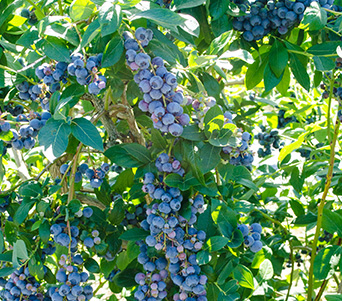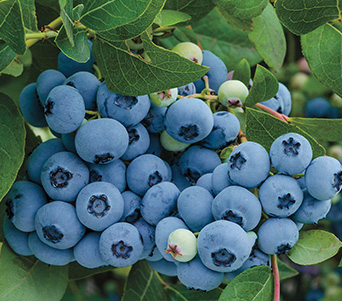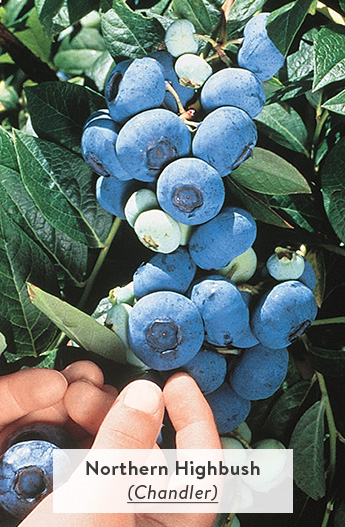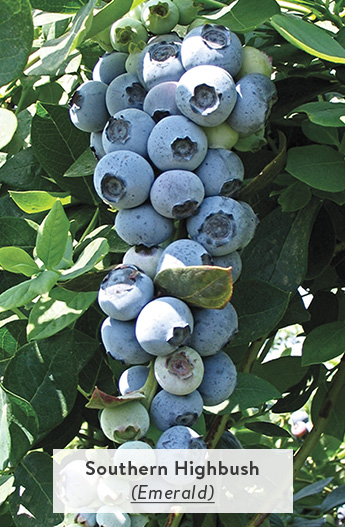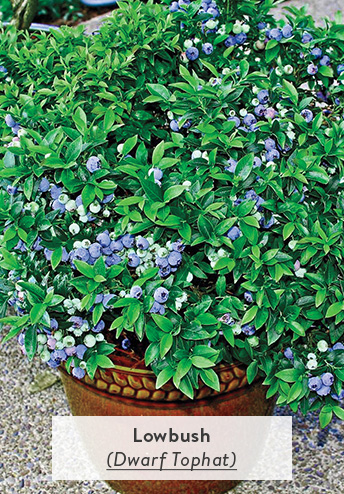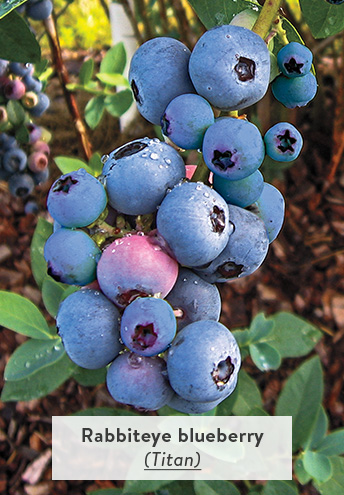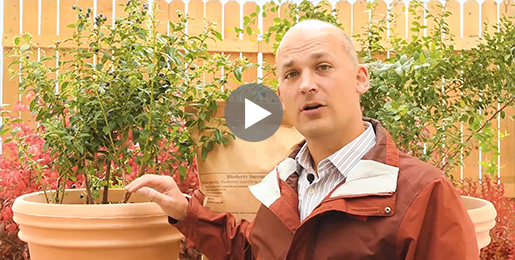Growing blueberries
A native fruit hits the big time
Consumed for centuries by native North Americans and cultivated for over 100 years on farms and in home gardens, blueberries have really hit the big time! Global production has skyrocketed in the last 15 years. Health benefits are the primary reason these flavorful and versatile berries are so widely planted and enjoyed around the world. Low in fat and sodium, blueberries are an excellent source of fiber, manganese and Vitamins C and K.
Blueberries didn't grow wild where I lived in southern Ohio, and no one I knew grew them, so when I went hiking in areas where they did grow, I was always thrilled to pick and eat the small, flavorful fruit. Years later, while visiting a friend who had a small farm in Maine, I saw one of the farmhands walk by with a big bowl of freshly picked blueberries from their cultivated patch. I could not get over the size of those fruit. My love of blueberries has since increased. I think you'll have the same experience as you learn more about blueberries and grow some of your own.
Native to North America and popular around the world, blueberries provide the fiber, manganese and vitamins associated with a healthy diet.
What questions should I ask before buying blueberry plants?
When you see blueberry plants for sale online, in a catalog or at the garden center, there are a number of questions to consider before purchasing.
-
What's the most flavorful blueberry variety?
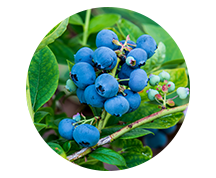
Ka-Bluey is the best with its explosive taste and crisp, sweet, richly flavored berries.
-
Will blueberries grow in my hardiness zone?
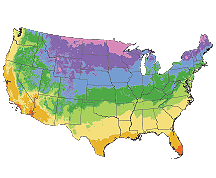
Blueberries can be grown as far north as zone 3 and as far south as zone 10.
-
How easy are blueberry plants to grow?

Check out our detailed
BLUEBERRY
PLANTING GUIDES
for more information
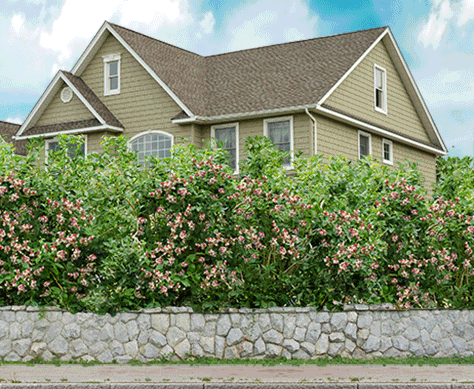
Blueberry bushes add beauty to home landscapes
Blueberries are an excellent choice for your home landscape because they provide three seasons of interest: delightful flowers in spring, blue fruit in summer, and red & orange foliage in fall.

Will blueberries grow in my hardiness zone?
There is hardly any area where blueberries can't be grown.
Sometimes gardeners in Northern regions feel neglected because many fruits are not cold hardy enough to grow in their colder zones. This is where blueberries come to the rescue. Several varieties are hardy even in zone 3. And with a hardiness range that extends down into zone 10, even gardeners in Southern regions can enjoy blueberries.
Which blueberry varieties grow best in my area?
To answer this question, let's look at the different types of blueberries:
- Northern Highbush blueberries
- Southern Highbush blueberries
- Lowbush blueberries
- Rabbiteye blueberries
- Duke blueberries
- Pink lemonade
Northern Highbush Blueberry
Northern Highbush blueberries (Vaccinium corymbosum) are the most common type of blueberry grown in the United States. Hardy in zones 3-8, they are native to much of eastern North America and can be found growing in moist, acidic soils. Northern Highbush blueberries were the first type of blueberry to be cultivated in a traditional farm setting and hybridized. These efforts started in the early 1900s and continue today.
Southern Highbush Blueberry
Southern Highbush blueberries are a cross of Northern Highbush (Vaccinium corymbosum) and Rabbiteye blueberries (Vaccinium ashei). Not quite as hardy as Northern Highbush, they bloom earlier and have lower chill-hour requirements. Southern Highbush blueberries are ideally suited for the Southeast, Mid-Atlantic, lower Midwest, Southern California and the Pacific Northwest.
Southern Highbush are more tolerant of heat and drought than Northern Highbush and they suffer from fewer diseases and insect pests. As true of other blueberries, it helps to have at least two varieties for pollination. A Northern Highbush will pollinate a Southern Highbush when their bloom times coincide.
Lowbush Blueberry
Lowbush blueberries (Vaccinium angustifolium) are the iconic fruit of the New England blueberry barrens, wide expanses of land with minimal vegetation. Native to northeastern United States and eastern Canada, they grow in very acidic, shallow soil, and their small, sweet fruit has intense blueberry flavor.
Long before European settlers arrived on the continent, Native American tribes regularly burned the wild barrens to keep them healthy and productive. Individuals and commercial enterprises still harvest berries from the barrens. The fruit can often be found in the frozen section of your local grocery store.
Rabbiteye blueberry
Rabbiteye blueberries (Vacinnium ashei) are native to the Southeast. These large bushes can grow 20' tall and are hardy in zones 7-9. In the northernmost part of the growing zone, Rabbiteye overlaps Northern Highbush. Typically, they require fewer chill hours and bloom earlier than Northern Highbush. Rabbiteye blueberries are very productive and tolerant of more alkaline soils. They are easy to grow and have few problems with insects or diseases.
Duke Blueberry
Duke Blueberry (Vaccinium corymbosum) grows 5-7 ft. tall, taller than many blueberry bushes. This makes it ideal to plant as a hedge for gardeners in zones 5-8. The blueberry plants produce high yields of light blue, medium-to-large berries with a good flavor, and the foliage turns yellow and orange in the fall.
Pink Lemonade Blueberry
Pink Lemonade Blueberry (Vaccinium) is the first-ever pink blueberry. Growing in zones 4-8, it bears deep pink fruit that's ready for harvest in late summer. The medium-size fruits have a mild, pleasant flavor and high sugar content--and they're rich in antioxidants, too. The blueberry plants grow 4-5 ft tall.
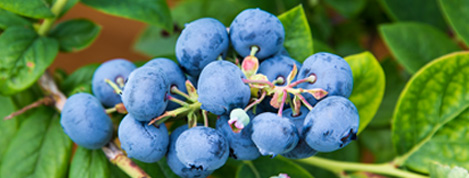
What's the most flavorful blueberry variety?
You can't go wrong with blueberries from Gurney's. All of our varieties have their merits, including delightful flavor. However, prepare to have 'Ka-Bluey' blow your mind. The explosive taste and crisp texture of its sweet and richly flavored berries are the standard against which all others should be judged.
How easy are blueberry plants to grow?
Cultivating blueberries is easy if you address a few specific requirements. You often read how they need very acidic soil to thrive. It is true, they do prefer an acid soil with a pH of about 5. However, with good drainage, proper fertilization and the addition of sulfur, you can grow blueberries in less acidic soil.
If possible, prepare your soil one year in advance of your plan to plant blueberry bushes. Start by getting a soil test. A soil test will help guide you to the proper soil amendments and rates of application. Generous amounts of peat moss and/or pine bark tilled into a mounded bed will help lower soil pH and add organic matter. Peat moss helps retain moisture, and pine bark improves drainage. Tilling in 3-4" of aged wood chips has also been shown to be beneficial.
An adequate water supply is critical to success. Blueberries are very shallow rooted plants and require frequent watering. It is especially important to keep the soil moist from bloom time through harvest. Feed your plants with a fertilizer blend that is specifically formulated for acid-loving plants. I recommend Gurney's Blueberry Food, which you apply twice each year—once at bloom time and again six weeks later.
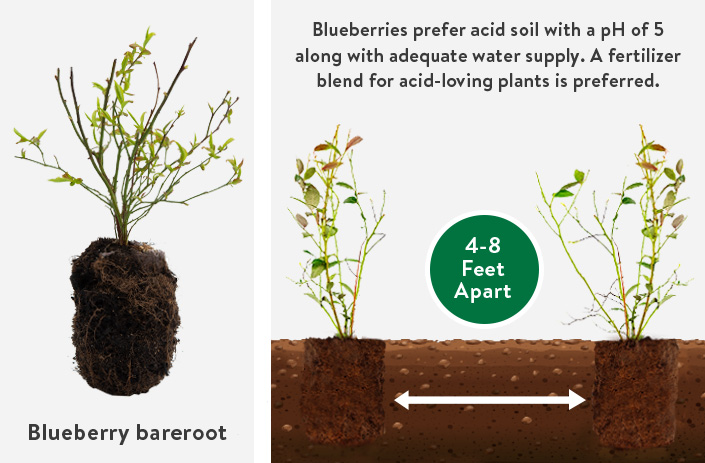
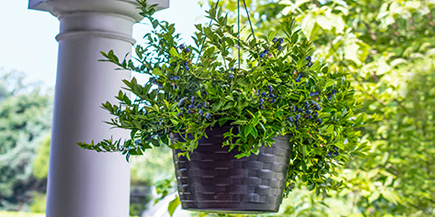
Can I grow blueberries in containers?
Blueberries grow very well in containers. In fact, it's much easier to control soil type, nutrients and moisture levels when growing blueberries in a potted environment. For potting soil, I recommend using Gurney's® Blueberry Success Fertilizer Mix or any high-quality potting soil amended with pine bark fines or peat moss. Feed your blueberries regularly with a fertilizer formulated for acid-loving plants.
We offer several half-high blueberry bushes that are perfect for containers and small spaces: Dwarf Northsky and Tophat grow only 1½' tall, and Dwarf Northblue grows only 2-3' tall.
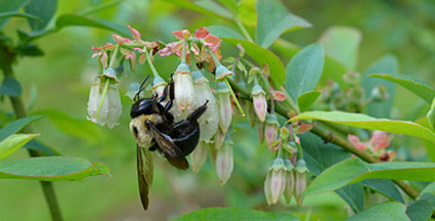
Do I need two varieties for cross-pollination?
Many blueberry varieties are self-fertile, meaning they don't need another variety to produce fruit. However, to ensure heavy fruit set and larger berries, it's important to plant at least two varieties. Remember to "bee friendly" and don't spray pesticides on your bushes when they are in flower.
Bumblebees, honeybees and many native bees pollinate blueberries. It's also good to have other flowering plants blooming throughout the growing season so our bees have plenty of nectar and pollen sources.
Will my blueberry plant produce fruit the first year?
A question often posted on our help line is, "Will my plant produce fruit the first year?" The answer is a bit complicated. Sometimes first year plants will produce fruit. However, you typically don't want your blueberry bush to produce fruit the first year—and sometimes not even the second year. Fruit production early in the life of a blueberry bush can stunt its growth and reduce overall production throughout its life. The best practice is to pinch off first-year blooms before they start setting fruit. In year two, if your plant is not well established and vigorous, it's wise to pinch off half of the second-year blooms. I know it's hard to pinch off blooms knowing you'll miss tasting fresh blueberries, but in the long run you'll be rewarded.
How long is the fruiting season?
In addition to ensuring good pollination, planting multiple varieties can extend your harvest. An 8 to 10 week harvest period is possible if you pay attention to ripening times. A good Northern Highbush combination for extending the harvest season would include Reka (early), Chandler (midseason) and Jersey (late season).
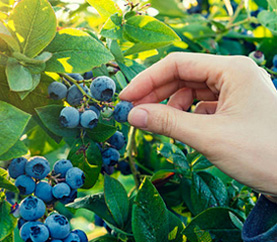
How will blueberry bushes affect the attractiveness of my home landscape?
Blueberries are an excellent edible, ornamental choice for your home landscape because they provide three seasons of interest. In the spring, the curious upside-down clusters of urn-shaped flowers will likely elicit comments from passersby. Because the flowers are a good source of nectar and pollen for native bees and honeybees, they are sure to attract better pollinators to your garden.
These fruiting plants are also attractive in the summer landscape. Gardeners are always longing to add blue color to their gardens. And who could deny the beauty of a bush fully loaded with powder-blue fruit?
When autumn rolls around, the brilliant oranges and reds of the fall foliage are rivaled by few other shrubs. The most stunning autumn color combination can be seen in our own double cropping Echo blueberry. Echo's second crop ripens as its foliage changes color. The sight of ripening blue fruit against a backdrop of dazzling red foliage is unforgettable!
-
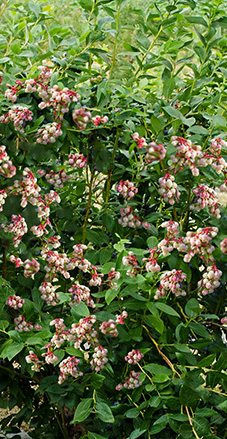
Spring Flowers
-
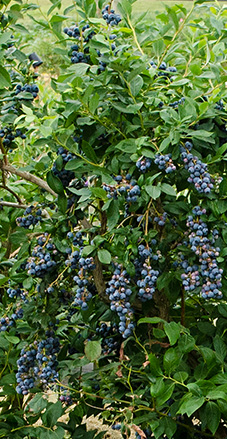
Summer Fruit
-
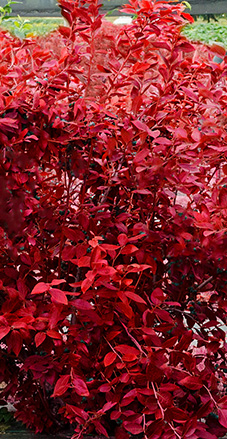
Fall Foliage
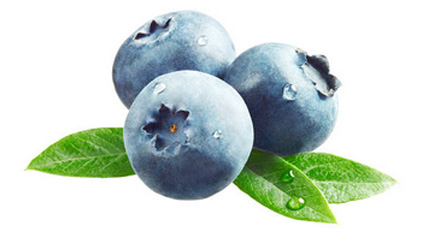
A horticultural heritage worth preserving
Blueberries have it all: flavor, health benefits and three-season beauty in the landscape. Now that you've expanded your knowledge of blueberries, take the next step and start growing them. You'll enjoy cultivating and consuming this delicious, native American fruit, harvested for centuries by people who came before us. Keep the tradition alive!





 Gardens Alive! & Supplies
Gardens Alive! & Supplies




